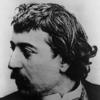More about The Yellow Christ

Contributor
Despite what it may look like, The Yellow Christ by Gauguin has nothing to do with Andres Serrano’s Piss Christ.
Gauguin made his Yellow Christ right before he bounced from France to the South Pacific in a protest of the Western world. He was over Paris and Parisians and the Salon and abandoned it all to go to Tahiti, but not before he made a pit stop in Pont-Aven in Brittany, France. This is where that unmistakable Gauguin style came to be – the palette of yellows, greens, reds and oranges, with hard lines. Eventually he had enough of the place and it’s lack of women who would pose nude for him, but for a while he was completely content in Brittany.
This depiction of a crucified Christ was inspired by a seventeenth century wooden crucifix in the Trémalo Chapel very near Pont-Aven. The women in peasant garb who surround him were, you guessed it, the peasants. The piety of these people was extreme. They prayed three times a day in a Catholic ritualistic prayer called Angelus, which seems like a lot but if you were raised Catholic, you get that being wildly bored is part of how you repent for your sins. But anyways, the worshippers who were immortalized in this painting believed that their farming had a Christ-like life cycle of birth, life, death, and rebirth and that praying was necessary for the success of their crops. They also made extra sure that the praying succeeded by working really, really hard.
This painting is the beginning of the end of Gauguin as an Impressionist. He got a taste of the simplicity and isolation that he so craved in Pont-Aven and never looked back. Soon he would leave for the South Pacific, where this style would only be strengthened. Unfortunately this was to the detriment of the young girls on the island who were subjected to Gauguin’s lecherous ways.
Sources
- "Le Christ Jaune (The Yellow Christ) | Albright-Knox." Albrightknox.org. Web. 12 Oct. 2018. https://www.albrightknox.org/artworks/19464-le-christ-jaune-yellow-chri…
- "The Yellow Christ, 1889 By Paul Gauguin." Gauguin.org. Web. 12 Oct. 2018. http://www.gauguin.org/the-yellow-christ.jsp
- Trend, Nick. "Paul Gauguin's Brittany: Where The Artist Discovered The Power Of Colour." Telegraph.co.uk. N.p., 2010. Web. 12 Oct. 2018. https://www.telegraph.co.uk/travel/artsandculture/8034097/Paul-Gauguins…
Featured Content
Here is what Wikipedia says about The Yellow Christ
The Yellow Christ (in French: Le Christ jaune) is a painting executed by Paul Gauguin in 1889 in Pont-Aven. Together with The Green Christ, it is considered to be one of the key works of Symbolism in symbolic mythological paintings of the older era as represented by Symbolism.
Gauguin first visited Pont-Aven in 1886. He returned to the village in early 1888 to stay until mid-October, when he left to join Vincent van Gogh in Arles, for little more than two months. Early in 1889, Gauguin was back to Pont-Aven to stay there until spring 1890. It was only for a short visit in summer 1889 to Paris to see the Exposition universelle and to arrange the Volpini Exhibition that Gauguin interrupted this sojourn. Soon after his return to Pont-Aven he painted The Yellow Christ.
The painting is a symbolic piece that shows the crucifixion of Jesus Christ taking place in 19th-century northern France as Breton women are gathered in prayer. Gauguin relies heavily on bold lines to define his figures and reserves shading only for the women. The autumn palette of yellow, red and green in the landscape echoes the dominant yellow in the figure of Christ. The bold outlines and flatness of the forms in this painting are typical of the cloisonnist style.
A study for The Yellow Christ in pencil is preserved in the Thyssen-Bornemisza Museum, and a version in watercolor is in the collection of the Art Institute of Chicago, gift of Elizabeth F. Chapman.
Check out the full Wikipedia article about The Yellow Christ












